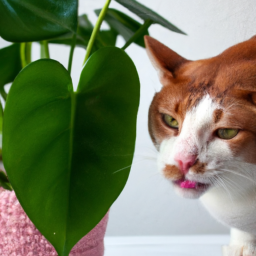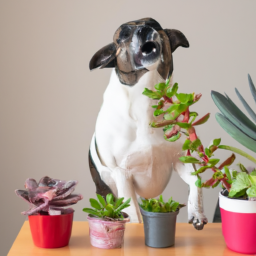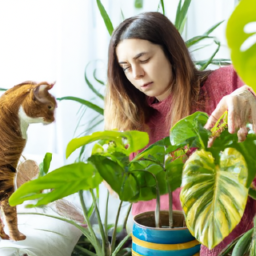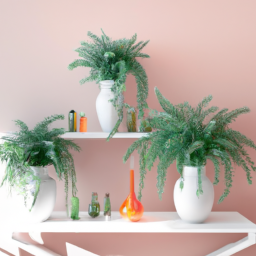
Are you a pet owner who loves to surround yourself with beautiful plants? If so, you may have wondered about the safety of certain plants for your furry friends. In this blog post, we will explore the topic of pet-friendly plants and how you can create a safe environment for your pets to enjoy. By incorporating pet-friendly plants into your home or garden, you can have the best of both worlds – a lush and vibrant space that is also safe for your beloved pets. So, let’s dive in and discover the wonderful world of pet-friendly plants, and how they can enhance your living space while keeping your furry friends out of harm’s way.
Selecting Pet-Friendly Plants for a Safe Environment
Welcome to our guide on creating a safe environment for your furry friends with pet-friendly plants! We understand how important it is to have a beautiful indoor or outdoor space while ensuring the safety of your pets. In this article, we will provide you with a step-by-step guide on selecting the perfect pet-friendly plants to create a safe and enjoyable environment for both you and your beloved pets.
Understanding the Importance of Pet-Friendly Plants
Before diving into the selection process, it’s crucial to understand why choosing pet-friendly plants is essential. Many common houseplants can be toxic to pets if ingested, leading to various health issues ranging from mild discomfort to severe poisoning. By selecting pet-friendly plants, you can eliminate these risks and create a worry-free environment for your furry friends.
When it comes to selecting pet-friendly plants, it’s essential to consider both toxicity and physical safety. Some plants may not be toxic but can still pose a risk if they have thorns or rough textures that can harm your pet’s paws or mouth. It’s crucial to strike a balance between aesthetics and safety to create a harmonious environment.
Identifying Pet-Friendly Plants
Now that we understand the importance of pet-friendly plants, let’s delve into the process of identifying them. Here are some key factors to consider:
1. Researching Pet-Friendly Plant Species
Start by researching pet-friendly plant species that are known to be non-toxic to pets. There are numerous resources available online, including pet-friendly plant databases, that provide comprehensive lists of safe plant options. Make sure to cross-reference multiple sources to ensure accuracy.
Some popular pet-friendly plant species include Spider Plants (Chlorophytum comosum), Boston Ferns (Nephrolepis exaltata), and Areca Palms (Dypsis lutescens). These plants not only add beauty to your space but are also safe for your pets to be around.
2. Checking for Toxicity Levels
While a plant may be considered pet-friendly, it’s essential to understand that different parts of a plant can have varying levels of toxicity. For example, the leaves of a plant may be safe, but the berries or flowers could be toxic. Always double-check the toxicity levels of each plant species and ensure that all parts are safe for your pets.
3. Considering Your Pet’s Behavior
Every pet has unique behaviors and tendencies. Some pets may be more curious and prone to nibbling on plants, while others may simply enjoy lounging around them. Consider your pet’s behavior when selecting pet-friendly plants. Opt for plants that can withstand occasional nibbling or choose hanging plants that are out of reach.
Creating a Safe Environment
Now that you have identified pet-friendly plant species, let’s explore how to create a safe environment for your pets:
1. Proper Placement
Consider where you will place your pet-friendly plants. If you have indoor plants, ensure they are placed in areas that are inaccessible to your pets. Hanging plants or placing them on high shelves can prevent your pets from reaching them. For outdoor plants, create designated areas where your pets are not allowed to roam freely to avoid accidental ingestion or contact with toxic plants.
2. Avoiding Harmful Chemicals
When caring for your pet-friendly plants, it’s crucial to avoid using harmful chemicals such as pesticides, fertilizers, or herbicides. These substances can be toxic to pets if ingested or if they come into contact with their paws or fur. Opt for pet-safe alternatives or natural remedies to maintain the health of your plants without endangering your pets.
3. Regularly Monitoring and Maintaining Plants
Regularly monitor your pet-friendly plants for any signs of damage or wilting. Remove any fallen leaves or flowers promptly to prevent your pets from playing with or ingesting them. Keep an eye out for any unusual behavior in your pets, as it may indicate that they have come into contact with a toxic plant. If you suspect ingestion or poisoning, contact your veterinarian immediately.
By following these steps and guidelines, you can create a safe and pet-friendly environment filled with beautiful plants. Remember, the well-being and safety of your pets should always be a top priority. Happy gardening!

Pet-Friendly Plants: Creating a Safe Environment
Understanding the Benefits of Pet-Friendly Plants in Your Home
Having pets brings immense joy and companionship to our lives. As responsible pet owners, it’s essential to create a safe and healthy environment for our furry friends. One way to achieve this is by incorporating pet-friendly plants into our homes. Not only do these plants add beauty and freshness to our living spaces, but they also offer numerous benefits for our pets.
Improved Air Quality
Pet-friendly plants play a crucial role in improving the air quality inside our homes. Just like humans, pets can be affected by poor indoor air quality, which can lead to respiratory issues and allergies. Certain plants act as natural air purifiers, filtering out harmful toxins and releasing oxygen, creating a healthier living environment for both humans and pets.
Some excellent pet-friendly plants known for their air-purifying properties include the Spider Plant (Chlorophytum comosum), Boston Fern (Nephrolepis exaltata), and Areca Palm (Dypsis lutescens). These plants not only remove toxins such as formaldehyde and benzene from the air but also help to maintain optimal humidity levels, reducing the risk of dry skin and respiratory discomfort for your pets.
However, it’s important to note that while these plants are generally safe for pets, it’s always wise to monitor your pet’s behavior around them. Some pets may still exhibit mild allergic reactions or digestive issues if they come into contact with certain plants, so it’s best to consult with a veterinarian if you notice any unusual symptoms.
Stress Reduction and Mental Stimulation
Pets, especially dogs and cats, can experience stress and anxiety just like humans. Incorporating pet-friendly plants into their environment can help reduce stress levels and provide mental stimulation.
Plants such as Catnip (Nepeta cataria) and Valerian (Valeriana officinalis) are known to have a calming effect on cats, helping to alleviate anxiety and promote relaxation. For dogs, plants like Lavender (Lavandula angustifolia) and Chamomile (Matricaria chamomilla) can have similar soothing effects. These plants can be placed in areas where your pets spend most of their time, such as their sleeping or play areas.
In addition to reducing stress, pet-friendly plants also provide mental stimulation. Cats, in particular, enjoy exploring and nibbling on plants. Incorporating safe plants like Cat Grass (Dactylis glomerata) or Catmint (Nepeta mussinii) can satisfy their natural instincts and keep them entertained.
Natural Remedies for Common Ailments
Another benefit of pet-friendly plants is their potential to provide natural remedies for common pet ailments. Some plants possess medicinal properties that can help alleviate minor health issues in pets.
Aloe Vera (Aloe barbadensis) is a well-known plant with various therapeutic properties. Its gel can be used topically to soothe minor skin irritations and burns in both dogs and cats. However, it’s crucial to ensure your pets do not ingest the Aloe Vera gel, as it can cause digestive upset.
For pets with digestive issues, including occasional upset stomach or constipation, adding a small amount of fresh, finely chopped Peppermint (Mentha piperita) leaves to their food can provide relief. Peppermint has natural antispasmodic properties and can help soothe the gastrointestinal tract.
It’s important to note that while some plants offer natural remedies, it’s always best to consult with a veterinarian before using any plant-based treatments for your pets. Not all plants are safe for ingestion or topical use, and some may interact with medications your pet may be taking.
Conclusion
Incorporating pet-friendly plants into your home not only enhances the aesthetics of your living space but also provides numerous benefits for your pets. From improving air quality and reducing stress to offering natural remedies for common ailments, these plants contribute to creating a safe and healthy environment for your furry friends.
Remember to research each plant thoroughly and ensure it is safe for your specific type of pet. Monitor your pet’s behavior around plants and consult with a veterinarian if you have any concerns. By creating a pet-friendly environment, you can enhance the well-being and happiness of both you and your beloved pets.

Tips for Creating a Pet-Friendly Garden with Non-Toxic Plants
Welcome to our guide on creating a pet-friendly garden with non-toxic plants. As pet owners, it’s important to ensure that our furry friends are safe and protected, even in our outdoor spaces. By incorporating pet-friendly plants into your garden, you can create a beautiful and safe environment for both your pets and your family to enjoy. In this article, we will provide you with step-by-step tips on how to create a pet-friendly garden with non-toxic plants.
Choosing Pet-Friendly Plants
When selecting plants for your garden, it’s crucial to choose ones that are safe for your pets. Some plants can be toxic to animals if ingested, causing a range of symptoms from mild gastrointestinal upset to severe poisoning. Here are some guidelines to help you choose pet-friendly plants:
Research: Before purchasing any plants, do thorough research to determine if they are safe for pets. There are many resources available online that provide comprehensive lists of toxic and non-toxic plants for animals. Make sure to cross-check the information from multiple sources to ensure accuracy.
Avoid Toxic Plants: Some common garden plants that are toxic to pets include lilies, azaleas, daffodils, tulips, and sago palms. It’s best to avoid these plants altogether to prevent any accidental ingestion by your pets.
Opt for Pet-Safe Alternatives: Fortunately, there are plenty of pet-friendly plants that can add beauty to your garden. Consider planting herbs like basil, rosemary, and thyme, which not only provide a delightful aroma but are also safe for pets. Other pet-friendly options include marigolds, sunflowers, and petunias.
Creating a Safe Environment
Once you have chosen pet-friendly plants for your garden, it’s essential to create a safe environment for your pets to roam freely. Here are some tips to ensure their safety:
Fencing: Install a secure fence around your garden to prevent your pets from wandering off or accessing areas that may pose a danger to them. This will also help protect your plants from being trampled or dug up.
Avoid Chemicals: Many common garden chemicals, such as pesticides and fertilizers, can be toxic to pets. Opt for natural alternatives or pet-safe products to maintain your garden without putting your furry friends at risk.
Remove Harmful Objects: Regularly inspect your garden for any potentially harmful objects like sharp tools, small rocks, or plastic pieces that could be ingested by your pets. Keep your garden tidy and free from any hazardous items.
Maintaining a Pet-Friendly Garden
Now that you have created a pet-friendly garden, it’s important to maintain it properly to ensure the safety and well-being of your pets. Here are some maintenance tips:
Regular Pruning: Keep your plants well-maintained by regularly pruning them. This will prevent overgrowth and reduce the risk of your pets getting tangled or injured by unruly branches.
Monitor Water Sources: Ensure that any water sources in your garden, such as ponds or birdbaths, are accessible to your pets but also safe for them to drink from. Avoid using chemicals or adding any substances that may be harmful to animals.
Train Your Pets: It’s crucial to train your pets to respect the boundaries of your garden. Teach them which areas are off-limits and discourage them from digging or chewing on plants. Positive reinforcement techniques can be effective in achieving this.
Creating a pet-friendly garden with non-toxic plants is a wonderful way to provide a safe and enjoyable outdoor space for both your pets and your family. By following these tips and guidelines, you can create a beautiful garden that will bring joy to everyone while keeping your furry friends safe from harm. Happy gardening!
In a Nutshell
If you’re a proud pet owner, creating a safe environment for your furry friend is probably high on your priority list. While we often focus on pet-proofing our homes by removing toxic substances and securing loose objects, we often overlook the potential dangers lurking in our own houseplants. Many common houseplants can be toxic to pets if ingested, causing anything from mild stomach upset to serious health complications. However, there’s no need to sacrifice your love for greenery in order to keep your pet safe. By choosing pet-friendly plants, you can create a harmonious and healthy environment for both you and your four-legged companion.
When it comes to selecting pet-friendly plants, it’s important to consider a few key factors. First and foremost, you’ll want to research the specific plants you’re interested in to ensure they are safe for your pet. Some popular pet-friendly options include spider plants, Boston ferns, and African violets, all of which are non-toxic to cats and dogs. Additionally, you should consider the placement of your plants within your home. Hanging plants or tall shelves can be a great option to keep them out of your pet’s reach. Lastly, it’s crucial to monitor your pet’s behavior around plants. Some pets may have a tendency to chew or dig in the soil, so it’s important to redirect their attention or use deterrents if necessary. By following these simple guidelines, you can create a pet-friendly space that allows both you and your furry friend to enjoy the benefits of indoor plants without any worries.
Here are some questions from our readers:
Q1: Are there any plants that are safe for pets?
A1: Yes, there are several pet-friendly plants that can create a safe environment for your furry friends. Some examples include spider plants, Boston ferns, money plants, and areca palms. These plants are non-toxic to cats and dogs, making them a great choice for pet owners.
Q2: What are some common plants that are toxic to pets?
A2: While there are many plants that are safe for pets, there are also some common ones that can be toxic. Examples of toxic plants include lilies, aloe vera, sago palm, and certain types of ivy. It’s important to be aware of these plants and avoid having them in your pet’s environment.
Q3: How can I create a safe environment for my pets with plants?
A3: To create a safe environment for your pets with plants, there are a few steps you can take. First, research pet-friendly plants and choose ones that are non-toxic. Place these plants in areas where your pets can’t easily access them, such as on high shelves or in hanging baskets. Additionally, consider using pet-safe fertilizers and pesticides to ensure your plants don’t pose any risks to your furry friends.
Q4: What are some signs of plant toxicity in pets?
A4: If your pet has ingested a toxic plant, there are several signs to watch out for. These may include vomiting, diarrhea, excessive drooling, difficulty breathing, lethargy, or changes in appetite. If you notice any of these symptoms, it’s important to contact your veterinarian immediately for guidance and assistance.
Q5: Can I still have indoor plants if I have pets?
A5: Absolutely! You can still enjoy the beauty and benefits of indoor plants even if you have pets. By choosing pet-friendly plants and taking necessary precautions, you can create a safe environment for both your plants and your furry friends. Just make sure to do your research, keep potentially toxic plants out of reach, and monitor your pets’ behavior around plants to ensure their safety.
Dr. Olivia Green is a botanist with over two decades of experience in indoor plant cultivation. She holds a Ph.D. in Plant Biology and has dedicated her career to researching plant behavior in controlled environments. Dr. Green is passionate about helping plant enthusiasts master the art of indoor gardening through her extensive knowledge and practical insights.


